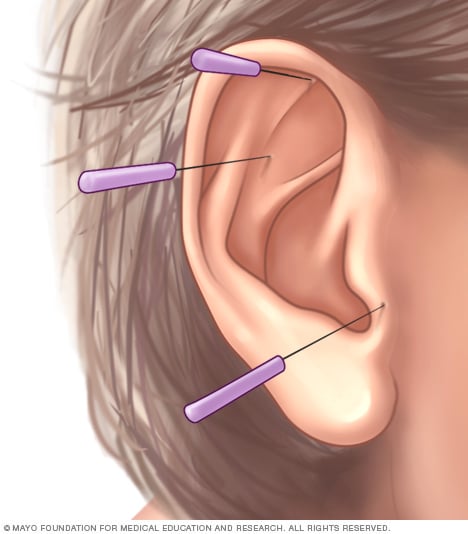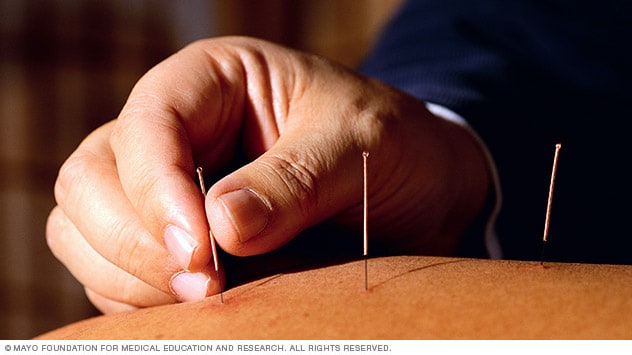Overview
Ear acupuncture

Ear acupuncture
Ear acupuncture involves placing acupuncture needles into specific points around the ear. These points are believed to correspond with specific organs, emotions or sensory feelings.
Acupuncture involves the insertion of very thin needles through your skin at strategic points on your body. A key component of traditional Chinese medicine, acupuncture is most commonly used to treat pain. Increasingly, it is being used for overall wellness, including stress management.
Traditional Chinese medicine explains acupuncture as a technique for balancing the flow of energy or life force — known as chi or qi (chee) — believed to flow through pathways (meridians) in your body. By inserting needles into specific points along these meridians, acupuncture practitioners believe that your energy flow will re-balance.
In contrast, many Western practitioners view the acupuncture points as places to stimulate nerves, muscles and connective tissue. Some believe that this stimulation boosts your body's natural painkillers.
Products & Services
Why it's done
Acupuncture is used mainly to relieve discomfort associated with a variety of diseases and conditions, including:
- Chemotherapy-induced and postoperative nausea and vomiting.
- Dental pain.
- Fibromyalgia.
- Headaches, including tension headaches and migraines.
- Labor pain.
- Lower back pain.
- Neck pain.
- Osteoarthritis.
- Menstrual cramps.
- Respiratory disorders, such as allergic rhinitis.
- Tennis elbow.
Risks
The risks of acupuncture are low if you have a competent, certified acupuncture practitioner using sterile needles. Common side effects include soreness and minor bleeding or bruising where the needles were inserted. Single-use, disposable needles are now the practice standard, so the risk of infection is minimal. Not everyone is a good candidate for acupuncture.
Before having acupuncture treatment, be sure to tell the practitioner if you:
- Have a pacemaker. Acupuncture that involves applying mild electrical pulses to the needles may potentially interfere with a pacemaker's operation.
- Are pregnant. Some acupuncture points are thought to stimulate labor, which could result in a premature delivery.
How you prepare
No special preparation is required before acupuncture treatment.
Choosing a practitioner
If you're considering acupuncture, take the same steps you would to choose a doctor:
- Ask people you trust for recommendations.
- Check the practitioner's training and credentials. Most states require that nonphysician acupuncturists pass an exam conducted by the National Certification Commission for Acupuncture and Oriental Medicine.
- Interview the practitioner. Ask what's involved in the treatment, how likely it is to help your condition and how much it will cost.
- Find out whether your insurance covers the treatment.
Tell your doctor that you're considering acupuncture. He or she may be able to tell you about the success rate of using acupuncture for your condition or recommend an acupuncture practitioner.
What you can expect
 Acupuncture treatment
Acupuncture treatment
During an acupuncture treatment, your acupuncturist inserts very thin needles into specific spots on your body. Insertion of the needles usually causes little discomfort.
Each person who performs acupuncture has a unique style, often blending aspects of Eastern and Western approaches to medicine. To determine the type of acupuncture treatment that will help you the most, your practitioner may ask you about your symptoms, behaviors and lifestyle. He or she may also closely examine:
- The parts of your body that are painful.
- The shape, coating and color of your tongue.
- The color of your face.
- The strength, rhythm and quality of the pulse in your wrist.
An acupuncture session may take up to 60 minutes, although some appointments may be much shorter. A common treatment plan for a single complaint would typically involve one or two treatments a week. The number of treatments will depend on the condition being treated and its severity. In general, it's common to receive 6 to 8 treatments.
During the procedure
Acupuncture points are situated in all areas of the body. Sometimes the appropriate points are far removed from the area of your pain. Your acupuncture practitioner will tell you the general site of the planned treatment and whether you need to remove any clothing. A gown, towel or sheet will be provided. You lie on a padded table for the treatment, which involves:
- Needle insertion. Acupuncture needles are inserted to various depths at strategic points on your body. The needles are very thin, so insertion usually causes little discomfort. People often don't feel them inserted at all. A typical treatment uses 5 to 20 needles. You may feel a mild aching sensation when a needle reaches the correct depth.
- Needle manipulation. Your practitioner may gently move or twirl the needles after placement or apply heat or mild electrical pulses to the needles.
- Needle removal. In most cases, the needles remain in place for 10 to 15 minutes while you lie still and relax. There is usually no discomfort when the needles are removed.
After the procedure
Some people feel relaxed and others feel energized after an acupuncture treatment. But not everyone responds to acupuncture. If your symptoms don't begin to improve within a few weeks, acupuncture may not be right for you.
Results
The benefits of acupuncture are sometimes difficult to measure, but many people find it helpful as a means to control a variety of painful conditions.
Acupuncture has few side effects, so it may be worth a try if you're having trouble controlling pain with more-conventional methods.